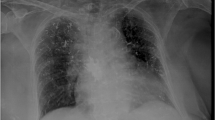Abstract
The intravertebral vacuum cleft sign (VCS) is an uncommon radiological sign, characterized by a radiolucent zone in the vertebral body. It is composed of 95% nitrogen and small amounts of oxygen and carbon dioxide. Post-traumatic ischemic necrosis could be its physiopathological mechanism, along with other pathologies like osteoporosis, corticosteroid therapy, diabetes, arteriosclerosis, alcoholism, multiple myeloma, bone metastasis and osteomyelitis. The broad diagnosis is made by antero-posterior X-ray, but computed tomography scan (CT scan) and magnetic resonance imaging (MRI) may help with the differential diagnosis. The aims of this paper are, on one hand, to communicate the clinical case of a 73-year-old osteoporotic woman with traumatic vertebral fractures who developed this sign in her radiological survey. On the other hand, its secondary aims are to review the medical literature about this sign and to show the clinical and radiological evolution after a percutaneous vertebroplasty.






Similar content being viewed by others
References
Theodorou DJ (2001) The intravertebral vacuum cleft sign. Radiology 221:787–788
Malghem JJ, Maldague BE, Labaisse MA, Dooms G, Duprez T, Devogelaer JP, Vande Berg B (1993) Intravertebral vacuum cleft: changes in content after supine positioning. Radiology 187:483–487
Maldague BE, Noel HM, Malghem JJ (1978) The intravertebral vacuum cleft: a sign of ischemic vertebral collapse. Radiology 129:23–29
Lafforgue PF, Chagnaud CJ, Daver LMH, Daumen-Legré VMS, Peragut JC, Kasbarian MJ, Volot F, Acquaviva PC (1994) Intervertebral disk vacuum phenomenon secondary to vertebral collapse: prevalence and significance. Radiology 193:853–858
Hashimoto K, Yasui N, Yamagishi M, Kojimoto H, Mizuno K, Shimomura Y (1989) Intravertebral vacuum cleft in the fifth lumbar vertebra. Spine 14:351–354
Galibert P, Deramond H, Rosat P, et al (1987) Preliminary note on the treatment of vertebral angioma by percutaneous acrylic vertebroplasty. Neurochirurgie 33:166–168
Deramond H, Wright NT, Belkoff SM (1999) Temperature elevation caused by bone cement polymerization during vertebroplasty. Bone 25:17S–21S
Garfin SR, Yuan HA, Reiley MA (2001) Kyphoplasty and vertebroplasty for the treatment of painful osteoporotic compression fractures. Spine 26:1511–1515
Belkoff SM, Mathis JM, Jasper LE, et al (2001) The biomechanics of vertebroplasty. Spine 26:1537–1541
Belkoff SM, Maroney M, Fenton DC, et al (1999) An in vitro biomechanical evaluation of bone cement used in percutaneous vertebroplasty. Bone 25:23S–26S
Acknowledgements
We wish to thank Eduardo Eyheremendi, MD, who performed the percutaneous vertebroplasty, for his invaluable help and Horacio Abud and Elina García Garrido for their technical support in carrying out this project.
Author information
Authors and Affiliations
Corresponding author
Rights and permissions
About this article
Cite this article
Sarli, M., Pérez Manghi, F.C., Gallo, R. et al. The vacuum cleft sign: an uncommon radiological sign. Osteoporos Int 16, 1210–1214 (2005). https://doi.org/10.1007/s00198-005-1833-4
Received:
Accepted:
Published:
Issue Date:
DOI: https://doi.org/10.1007/s00198-005-1833-4




